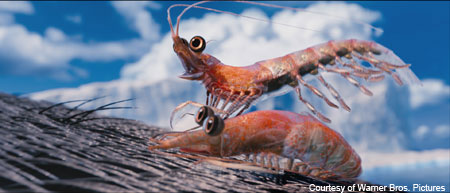Action! Pew Calls for Extra Resources to Protect Penguin Food
Actors Damon and Pitt Give Tiny Krill Big Exposure in New ‘Happy Feet' Sequel

Will and Bill, the Krill, in Warner Bros. Pictures' and Village Roadshow Pictures' animated adventure “Happy Feet Two,” a Warner Bros. Pictures release.
Tiny krill are about to take centre stage at the 30th Commission for the Conservation of Antarctic Marine Living Resources (CCAMLR) meeting, where governments will consider greater protection for the shrimplike crustaceans that are the building blocks of the Antarctic food chain. The attention these little animals receive will be amplified in mid-November, when the sequel to the film “Happy Feet” opens, with Matt Damon and Brad Pitt playing krill characters.
Krill, a largely unknown but critical ocean species, are the primary food source for penguins, whales, and seals in the Southern Ocean. However, demand for these animals as feed for industrially farmed fish and to produce high-value oils used in nutritional supplements is triggering an expansion of the fishery beyond a level that its population can sustain. Left unchecked, krill fishing in certain areas could outpace efforts to protect the well-known species that depend on it.
“It is perfect timing that two of Hollywood's biggest names are portraying the smallest actors in one of the world's most pristine ocean ecosystems,” says Gerald Leape, a senior officer at the Pew Environment Group. “Existing efforts to regulate krill catch must be sustained and enforced, so that animals such as penguins and seals are not competing against industrial fishing vessels just to survive.”
In the past decade, fleets from more countries have begun to fish for krill. Some have adopted fishing technologies and methods that allow them to catch and process this species continuously, resulting in much higher catches. These operations, combined with accelerating loss of the sea ice that provides essential habitat for krill, threaten to deplete stocks in key feeding areas for penguins, seals, and whales.
From 24 October-4 November 2011, CCAMLR, a regional fisheries management organization whose mandate is to conserve the marine life of the Southern Ocean, is meeting in Hobart, Tasmania, Australia. Its 25 member governments include the United States, Australia, New Zealand, Chile, Argentina, the European Union, China, South Korea, Russia, Ukraine, Norway, and Japan.
The Pew Environment Group is asking CCAMLR delegates at this month's meeting to:
- Require observers on all krill-fishing vessels.
- Set up a dedicated fund to monitor populations of krill predators.
- Maintain smaller sub-area divisions of the ocean to manage krill, in order to prevent local depletions that will harm animals such as penguins.
Editors Notes:
- According to a recent 2011 paper in the Proceedings of the National Academy of Sciences, which was funded by the Lenfest Ocean Program, the availability of krill is likely to explain changes in penguin abundance. Adélie (“ice-loving”) and chinstrap (“ice-avoiding”) penguin species have declined by more than 50 percent in the South Shetland Islands region of the Antarctic since the 1970s. If warming continues, winter sea-ice may disappear from much of this region and exacerbate krill and penguin declines. More on the Lenfest Ocean Program penguin study (PDF).
- Krill have an exotic appearance, with a translucent, reddish shell and large black eyes. They spend most of their 5-7 year life span in huge schools "swarms," living in concentrations so dense and vast that they cover kilometers in every direction with as many as 30,000 per cubic meter.
- The first “Happy Feet” movie had a strong conservation message. The main character, a penguin named Mumble, seeks an explanation for a dramatic fish shortage and discovers that humans are wreaking havoc on his kind by overfishing the oceans.







